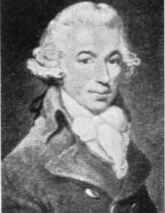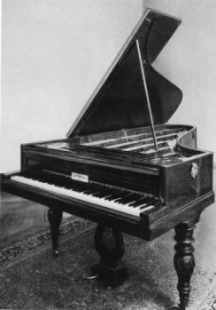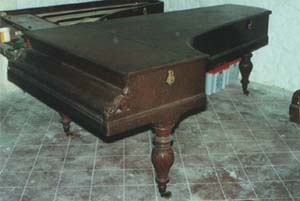
Pleyel
Stephen
Birkett
 |
Pleyel |
Stephen
Birkett
|
Research
Teaching
Music
|

| Ignaz Pleyel (1757-1831) was active as a composer, music publisher and piano builder. He founded the firm of Pleyel et Cie in Paris in 1807. His eldest son, Camille Pleyel (1788-1855), was taken in as a partner in 1815, and assumed a leading role in the 1820s, maintaining a close relationship with many famous musicians and artists, including Chopin. A concert hall, Salles Pleyel, was opened in 1830, and in this hall Chopin gave his first (1830) and last (1848) Parisian concerts, along with many others between these years. The 1836 Pleyel used in Michel Boegner's recent recording of the nocturnes is known to have been used in the Salles Pleyel during the time when Chopin was active there. | |||||
| A contemporary account of the qualities of
a Pleyel piano describes the sound a "acquiring a special satisfying quality,
the upper register bright and silvery, the middle penetrating and intense,
the bass clear and vigorous. The striking of the hammers has been designed
to give a sound that is pure, clear, even, and intense. The carefully made
hammers produce - when one plays piano [i.e. p] - a sweet and velvety
sound that gradually increases in brightness and volume as one applies more
pressure on the keyboard." (Montal, L'art d'accorder soi-meme son piano,
Paris, 1836). Chopin's 1839 Pleyel, shown at the right, was put at his disposal (perhaps by Pleyel), between 1839 and 1841, after which time it was sold for 2200 Francs. It has a compass of 6 octaves and a fifth from CC to g4. By 1847, when he acquired his last Pleyel grand, the compass was a full seven octaves, from AAA to a4. None of Chopin's music requires the extra notes below CC, fitting perfectly the six and one half octave keyboard of the earlier instrument. |  | ||||||
1843 Pleyel CC-f4 6.5 octaves
| 1839 Pleyel CC-f4 6.5 octaves
| ||||||

| |||||||
| Pleyel introduced iron bracing to support the wooden framing as early as 1825, when three wrought iron bars (i.e. not cast iron frame) were used over the strings. A Pleyel from the Chopin period ca 1839 had five iron braces attached to a wide hitch plate (the part to which the strings are attached at the end furthest from the player), with perpendicular cross-braces between them, and attached for rigidity in the middle via bolts that pass through the soundboard into the wooden bracing members below. By 1850 the number of braces was reduced to three by using stronger T-section material, as compared to the earlier rectangular section bars. | |||||||
Pleyel pianos retained the tonal clarity of straight-stringing as late as 1878. The length of approximately 220 cm was typical of straight-strung concert grand pianos throughout the nineteenth century. Two pedals, una corda and damper-lifting, with felt over-dampers, were standard on Pleyels. (By design choice) damping was not as instantaneous as one would expect on a modern piano, producing an after-ring which is quite characteristic. Pleyel, as well as other builders such as Boisselot et Fils, retained the simple, light, single escapement action, essentially the English grand action, until well into the century providing a more direct touch alternative to the double escapement action of the competitor Erard. | |||||||
mp3 samples | |||||||
Michele Boegner (Pleyel, 1836). Calliope CAL 9281.2 | |||||||
| |||||||
External links | |||||||
Jean Louchet, Pianos Pleyel et Erard | |||||||